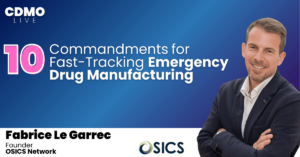“The idea is to get the information in real time. And for that, you would go and see what systems you have at hand, what system your CMO is using, and find a joint, so called ‘Safe Space’, which serves both sides.” – Ingrid Lux
Ingrid Lux serves as Lead Quality Disposition in Oncology & Small Molecule External Supply Europe at Takeda, bringing extensive experience from her previous 16 years at Sandoz. Her expertise spans pharmaceutical quality management, with a particular focus on cross-functional collaboration and external manufacturing partnerships.
In the latest PharmaSource podcast episode, Ingrid shares valuable insights on managing quality across external manufacturing networks, creating effective partnerships with CDMOs, and navigating the evolving landscape of pharmaceutical quality oversight in an increasingly complex global environment.
The Evolution of Quality Oversight in External Manufacturing
Ingrid’s career in pharmaceutical quality began during a pivotal transition period for the industry. She witnessed firsthand the consolidation of smaller companies into larger entities and the emergence of external manufacturing as a strategic approach.
“I joined pharmaceutical industry exactly at a period of transition. The companies I joined were small companies, but complete companies. Each and every of them had everything – development, manufacturing, marketing, registration – all at one site, in one hand. At the time I was joining, it was the period of consolidation. Big players bought the smaller players,” explains Ingrid.
This industry shift created a new pathway for quality professionals. “There was a new path opening, and this path was called competent, releasing products from outside the own site, the own company which were selling them. It was a step of consolidation,” she reflects. “You took responsibility for products which weren’t manufactured at the site you were directly overseeing. So it was the period when quality systems evolved over the borders of the own organisation, which implied a lot of coordination and cooperation with different organisational cultures, people cultures.”
Breaking Down Silos for Effective Quality Management
When Ingrid first entered the pharmaceutical industry, she observed significant silo thinking and a perception of quality as a roadblock. She takes pride in being part of the transformation that has occurred since then.
“I was struck by the silo thinking and also considering quality as a road block. In the end, somehow like an enemy you need to hide everything from and trick them to release the product to the market,” she recalls. “This completely changed, and I feel pride myself to be part of the transformation journey we have undergone.”
Ingrid emphasises the importance of breaking down these silos: “All functions in global pharmaceutical companies living in our silos do have our strength. And in each of our silo we breed our strength. For quality, there are KPIs like deviation, change controls, quality agreements. But these tools, which need to be sharpened and perfection within the silo, cannot only stay there. They need to serve all the other departments.”
She advocates for a unified approach: “We want to have the same goal – a good, solid and robust product. And to achieve that, we are fulfilling the needs of GMP, of Good Manufacturing Practice, which means a deviation is mentioned and informed about, and change controls are monitored because that gives the robustness of the process, the robustness of the product in the market.”
Creating ‘Safe Spaces’ with CDMOs for Real-Time Information Sharing
One of Ingrid’s innovative approaches to external manufacturing partnerships is the concept of creating a “common room” or “safe space” when working with CDMOs. This space enables real-time information sharing while protecting both parties’ sensitive data.
“The idea is to get the information in real time. And for that, you would go and see what systems you have at hand, what system your CMO is using, and find a joint, so-called Safe Space, which serves both sides,” Ingrid explains. “The CDMO would enter the figures in real life, and they would be transposed in real life in the interface you can see and read.”
This solution addresses confidentiality concerns from both sides: “This interface needs to protect both sides of having information which wasn’t authorised either by the one side that you can read it. And the receiving side would like to protect herself in allowing the providing site to see too much of the own information, the own data you have.”
Navigating Digital Integration Challenges
The pharmaceutical industry’s digital transformation journey has evolved significantly, presenting new challenges for quality professionals working with external partners. Ingrid identifies several key challenges in this area.
“In the beginning, the big challenge was to get the data, which previously was on paper, to transfer it into the systems in a smart and wise way,” she explains. “Now the new challenges are, everybody has its own system, and to bring these systems together and make them cooperate meant working on interfaces.”
She notes that the industry has progressed beyond basic IT implementation: “We are no longer in the IT project phase. We are in the pure digitalization phase. We need to transition the processes and the understanding into digitalization and cooperate with artificial intelligence and understand where this artificial intelligence can help our own stupidity and where it is lying to us.”
Data ownership presents another challenge: “Who is owning which data? You are expecting that what is coming out of the system is holy and safe and sound. The reality is it is only as sound and safe as the data entered were, and for that, specialists and product and process owners need to maintain or to cooperate with IT in order to maintain the correct status of information.”
Just-in-Time Quality Management
Ingrid makes an important distinction between speed and precision in quality management processes. Rather than simply moving quickly, she advocates for carefully defined processes with clear timelines.
“I have spoken about just-in-time, which is not the same [as speed],” she clarifies. “Speed would mean rush, but a clear definition of time, clear agreements, and their authenticity, taking into account the authenticity of the different processes – this ensures a reliability which might be perceived as speed because it was finished right in time, just-in-time.”
She beautifully compares this approach to dancing: “I would like to compare it with dancing. Most of the time you are moving and you need to maintain the rhythm, and at a certain moment, the music gets more intense and you are prepared to do the most speechful and impressive movements because you were prepared.”
Practical Strategies for Quality Professionals Managing External Networks
Drawing from her extensive experience, Ingrid offers several actionable approaches for quality professionals navigating the complexities of external manufacturing partnerships:
Building Cross-Cultural Bridges “With external partners, it’s the same as in the beginning. It’s the language, the culture, the organisation. You need to get in contact with people to create the same understanding,” Ingrid emphasises.
She recommends regular communication touchpoints combined with formal documentation: “This is indeed by communication, conversation, informal conversation, but in the same time, consolidated information in documents like quality agreements or change control systems.”
Implementing Joint Problem-Solving Frameworks One of Ingrid’s key success strategies is establishing collaborative problem-solving mechanisms. “The secret of success was joint problem solving. These teams had solved problems before, all together with the mentality we want to really understand what has happened in order to have a sound future process.”
Her practical tip: “Solve seven big problems together, and then the silos are going to melt.” By tackling significant challenges as a unified team, departments naturally begin to break down their barriers and develop mutual understanding.
Creating Early Quality Involvement Processes Ingrid emphasises the importance of quality teams being involved from the earliest stages of product development: “You communicate the quality needs, which means in the same time, understanding of what is happening in the development moment.”
She recommends implementing a structured approach to questions and answers: “These questions need to be in a structured way, and need to receive a structured answer. Demanding to have these answers until you progress to the next step is one of the secrets of maintaining quality throughout the process.”
Establishing Data Validation Protocols When working with external partners’ data, Ingrid recommends implementing specific validation protocols: “If you are an expert in your domain, you can understand the consistency of data you are receiving. So you might not be able to read out the detail, but if the conclusion does not fit in the big picture, you will go and start and go down the thread to understand where this inconsistency comes from.”
She advises quality professionals to develop expertise that allows them to validate AI-generated information: “The human expertise is still essential to understand how AI is working and how it can support.”
Developing Contingency Planning for Logistics Addressing current challenges in global supply, Ingrid recommends developing robust contingency plans: “What is currently our challenging situation is, how do we move products best by flight or by sea, what is serving the purposes and the conditions best?”
She advises quality professionals to balance inventory strategies with release assurance: “If you can rely on your quality releases, you would lower the inventory, but in the same time, you need to have a sound control on the entire logistic lane.”
Maintaining Perspective and Purpose Perhaps most importantly, Ingrid emphasises maintaining a balanced perspective when applying quality standards: “We have a lot of rules and systems which are important to be followed, but please do not get mad with them. Do not take them by the letter. Understand what’s behind it, and even if the letter is essential in that context, understand why it is essential.”
This approach enhances not only compliance but communication: “It creates an easier basis for communication, because if you get mad, it means you get stuck on a certain idea, and this won’t promote anything, neither compliance nor product nor effectiveness.”
By implementing these practical strategies, quality professionals can more effectively manage external manufacturing relationships while ensuring both compliance and operational excellence. Ingrid’s experience demonstrates that with the right approach, quality can transform from being perceived as a roadblock to becoming a key enabler of successful external partnerships.












 Stay ahead of trends and best practices
Stay ahead of trends and best practices
